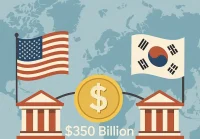Russia’s worker shortage didn’t start with the war in Ukraine. It was seeded in the 1990s, when the Soviet Union collapsed and the economy imploded. GDP fell roughly 40% from 1991 to 1998; unemployment spiked; hyperinflation vaporized savings; social services broke. Births plunged while deaths surged, creating the notorious “Russian cross”: rising mortality intersecting with falling fertility. Male life expectancy slid from 64 years in 1989 to 57.6 by 1994. The 1990s cohort that never arrived is the missing labor force of the 2020s.
Fertility never recovered to replacement. It bumped to 1.78 in 2015, then fell again to ~1.4 by 2023. Meanwhile, the population aged. Citizens 65+ climbed from ~10% in 1990 to ~16.6% in 2023, while the under‑16 share shrank. Fewer entrants, more retirees—the pension math stopped working, and employers began to run out of candidates long before tanks rolled across the Ukrainian border.
War Turned A Slow Bleed Into A Sprint
When Russia invaded Ukraine in 2022, labor was already tight. Mobilization pulled hundreds of thousands of working‑age men from factories, logistics, and services into the ranks. Casualties mounted. Conservative estimates put total Russian casualties by mid‑2025 above one million, with hundreds of thousands killed—prime‑age workers who will never return to the economy or the family formation pipeline.
Then came the exodus. Between 2022 and 2023, hundreds of thousands—many young, educated, and in tech—left for Armenia, Georgia, Kazakhstan, the EU, and the Gulf. The IT sector alone reportedly lost up to a fifth of its workforce. The people Russia most needed to modernize its economy voted with their feet.
By 2025, unemployment fell to ~2.2%—a rate that signals not strength but scarcity. Defense factories and the military began competing for the same shrinking pool of skilled labor. Sign‑on bonuses and wartime pay soared to entice contract soldiers, draining talent from industry and driving a wage bidding war the state can’t sustainably fund.
An Economy Built On Oil, Not People
Russia’s post‑Soviet model doubled down on hydrocarbons. Oil and gas generated up to two‑thirds of export revenue and a large share of the budget in peak years, yet directly employed only about 1.5% of workers. Easy resource rents crowded out manufacturing and services, rigidified the labor market, and tethered government spending to commodity cycles. Geography compounded the problem: good-paying resource jobs were far from where most Russians live, and relocation to harsh regions never scaled.
The war amplified every weakness. Defense and security outlays ballooned toward 40% of the federal budget—nearly 8% of GDP—while sanctions, tanker workarounds, and refinery strikes pressured energy revenues. The state increasingly compelled firms to accept defense contracts at uneconomic prices, even criminalizing non‑delivery, which further distorted investment and hiring. Growth projections slid, inflation stayed sticky, and the ruble weakened, eroding real wages.
Migration Can’t Fill The Gap
For decades, millions of Central Asian migrants kept construction, agriculture, and services running. That pipeline is drying up. A weaker ruble cuts real pay; legal risks and mobilization fears deter newcomers; and rival destinations—from Kazakhstan and Turkey to Gulf states and South Korea—offer safer, better‑paid work. Even when migrants arrive, they can’t replace departed engineers, coders, and machinists, nor are they eager to populate Siberian oil fields or far‑eastern defense hubs. Xenophobia and policing hassles add frictions that repel long‑term settlement.
The Ukrainian Wild Card That Backfired
If war planners imagined that a subdued Ukraine could supply a culturally compatible labor pool, the opposite occurred. Ukraine’s population crashed via occupation, refugee flows to Europe, battlefield losses, and a wartime birth‑rate collapse. Every Ukrainian who resettles in the EU is one fewer potential worker for Russia—and Ukrainian identity has only hardened against absorption.
The Ukrainian Wild Card That Backfired
What was meant to be a geopolitical advantage has become a demographic and strategic setback. War, displacement, and a collapsing birth rate have drained Ukraine’s workforce — and strengthened its national identity. Each refugee rebuilding life in the EU represents not just loss for Russia, but resilience for Ukraine and a redefined European labor map.
Explore Geopolitics & International Policy Roles →A Shrinking Future
Births in Russia fell to nearly post‑Soviet lows in 2024. With a smaller 1990s cohort now of child‑bearing age, each year yields fewer parents and fewer children. It will take decades for any pro‑natalist policy to move the needle—and only if households believe in a stable, prosperous future. Automation could ease shortages, but it requires capital, imported technology, and open supply chains—precisely what sanctions and war disrupt. Immigration cannot scale enough, and many source countries are aging, too.
The likely path is a slower, poorer Russia: a nuclear‑armed, resource‑rich state with eroding capacity to maintain infrastructure across vast distances. Regions will demand more autonomy as Moscow struggles to pay and staff essential services. Worker scarcity will keep choking output, tax receipts will lag, and the budget will prioritize guns over butter, deepening the civilian squeeze.
Frequently Asked Questions
Why is unemployment so low if the economy is weak?
Because the constraint is people, not demand. A 2–3% jobless rate reflects a labor shortage, not a boom.
Can higher birth rates solve this?
Not soon. Babies take two decades to reach the workforce, and families don’t expand amid insecurity and falling real incomes.
What about migrants from Central Asia?
They help in low‑wage sectors but can’t replace lost skilled workers or fill remote defense and energy sites at scale.
Could automation offset the gap?
Partially, over time—if Russia can finance, source, and maintain advanced machinery under sanctions and capital controls.




